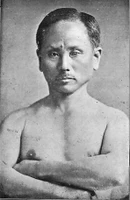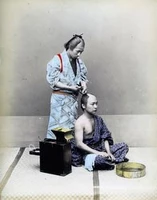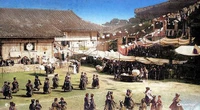A Brief History of Shotokan Karate
Karate originates from the island of Okinawa. Okinawa itself is a small island at the southernmost point of the chain of islands that comprise modern-day Japan. It is situated 400 nautical miles east of mainland China, 300 nautical miles south of mainland Japan, and an equal distance north of Taiwan. Being at the crossroads of major trading routes, its significance as a “resting spot” was first discovered by the Japanese.
In 1340, Okinawa was divided into three kingdoms, Chuzan, Nansan, and Hokusan. The largest of the kingdoms, Chuzan, entered into a formal, tributary relationship with China. Okinawa’s King Satto and China’s Ming Emperor ratified this treaty in 1372 and diplomatic exchanges began. It is recorded that these diplomatic delegations included people knowledgeable in the martial arts of their respective countries. Furthering the cultural exchange was a community of artisans and clergy from China who settled in Okinawa in 1393, bringing with them knowledge of shipbuilding, navigation, paper, ink, and pen production, and, of course, kempo: Chinese boxing.
By 1429, Chuzan had succeeded in absorbing the other kingdoms, and Okinawa was united under one king, King Sho Hashi. Thus, the Sho Dynasty was founded. This was the heralding of a golden age for Okinawa and trade between the island and the rest of the Pacific Rim flourished. For nearly 40 years, life in Okinawa was peaceful, until 1470, when the Sho Dynasty collapsed, leaving the island in turmoil for the next seven years.
In 1477, peace came to Okinawa again with the founding of a new Sho Dynasty. Faced with rebellious warlords, the new king, King Sho Shin, enacted a ban forbidding all Okinawans from carrying weapons. In 1609, frustrated by Okinawa’s refusal to recognize the new Japanese Shogunate, an army of Satsuma clansman invaded Okinawa and crushed the island’s defenses. Japan, at that time, had a similar ban on the bearing of arms, and so the edict forbidding weapons continued to be enforced.
It is believed that the ban on carrying weapons is what led to the practice of te, unarmed combat. Secret schools for the practice of te began to develop, and the practice of unarmed combat continued in secret until the early 20th century.
Originally, a distinction was made between Kara-te and Okinawan-te. The written symbols for the words Chinese and empty are both pronounced “kara”. In its earliest forms, kara-te referred to “Chinese hand”. The Okinawan adaptation of this art was Okinawa-te, Okinawan hand. It is believed that te has been practiced in Okinawa for at least a thousand years. From the 14th century on the art was increasing influenced by Chinese boxing, kempo.
Te developed over the years, primarily in three Okinawan cities: Shuri, Naha, and Tomari. Different forms of self-defense developed within each city and subsequently became known as Shuri-te, Naha-te and Tomari-te. Collectively they were called Okinawa-Te or Tode.
Gradually, Tode divided into two main groups; Shorin-ryu which developed around Shuri and Tomari, and Shorei-ryu which came from the Naha area. Since these towns were all in close proximity to one another the basic techniques of each style didn’t differ so much as the emphasis of the style. It has been suggested that these two styles were developed based on different physical requirements. Shorin-ryu (flexible-pine school) was quick and linear with natural breathing while Shorei-ryu (hard and soft school) emphasized steady, rooted movements with breathing in synchrony with each movement.
Tode continued to be practiced in secret, even after the end of the Satsuma rule in 1872. The schools finally became public again in 1902, when Commissioner of Education Shintaro Ogawa recommended that Tode be included in the physical education of the first middle school of Okinawa.
Eventually in 1935, a research group was set up at Keio University with the goal of standardizing the practice of karate.
One of the members of this panel was Gichin Funakoshi, and it was his suggestion that all karate be renamed Dai Nippon Kempo Karate-do. Literally, Greater Japanese, Fist-method, Empty-handed way. His suggestion that the character for empty be used instead of the traditional character for Chinese sparked a great deal of controversy, but eventually, his idea prevailed, and in Japanese today, karate is written with the characters which mean “empty hand”.
While the need for a true combat martial art had declined by the advent of the 20th century, karate’s value as a way of building character and promoting health was recognized, and it was soon being taught in many of Okinawa’s schools. The first karate master to teach in public school was Anko Itosu. He was soon followed by others, including Chojun Miyagi, Kenwa Mabuni, and Gichin Funakoshi (the founder of Shotokan).
Sources: The Way of the Warrior, Howard Reid & Michael Croucher, Century Publishing; Karate-Do – My Way of Life, Gichin Funakoshi, Kodansha International





